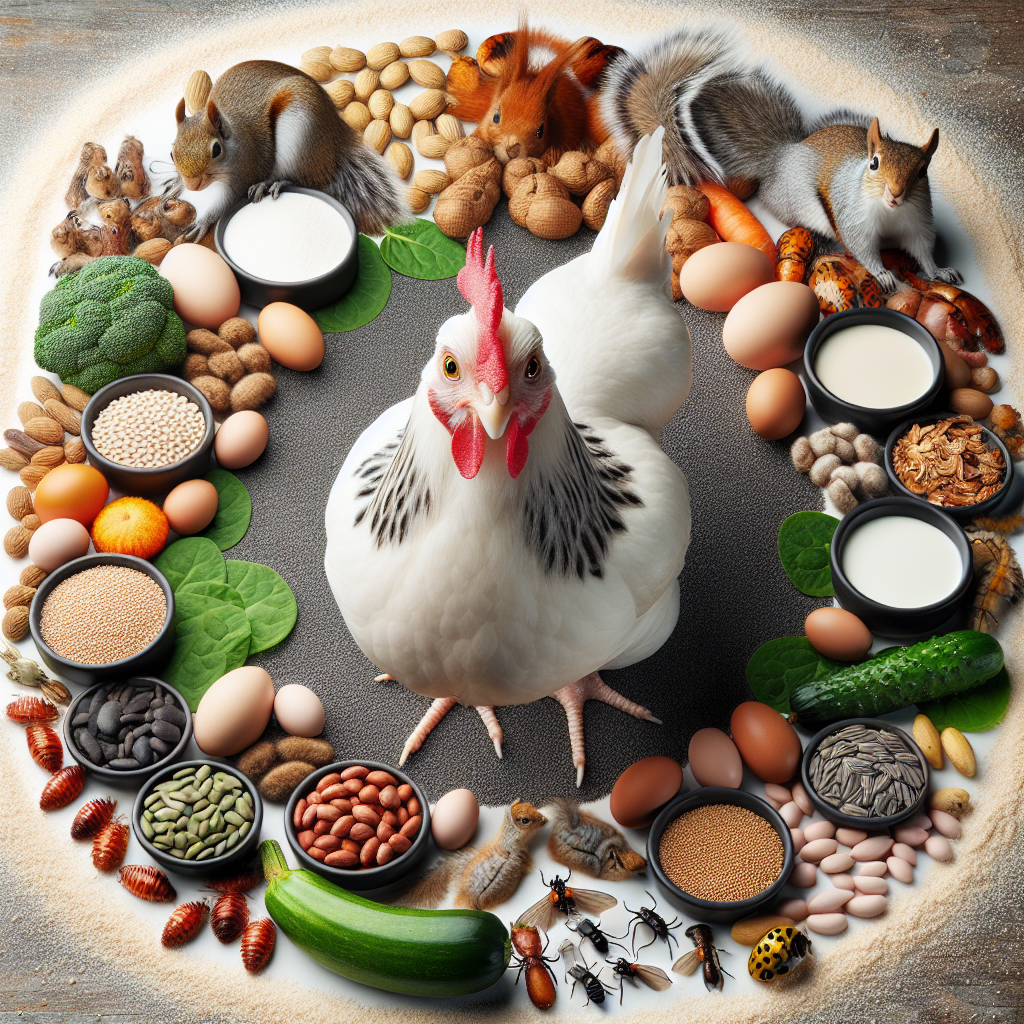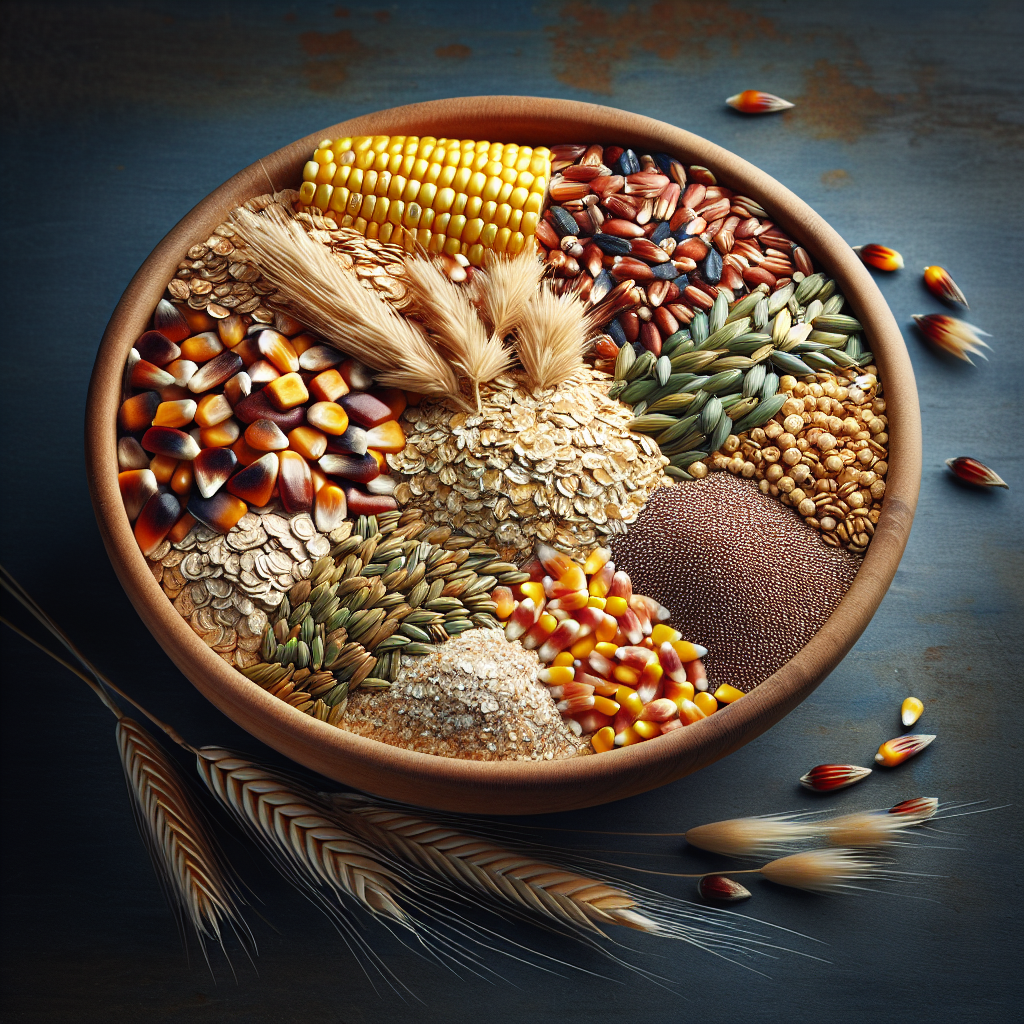If you’re a backyard chicken enthusiast, you may have wondered about the benefits of soy-free chicken feeds and where they get their primary protein sources. Well, wonder no more! In this article, we’ll explore the advantages of soy-free chicken feeds and uncover the secret behind their protein-rich ingredients. So, whether you’re new to raising chickens or looking for alternative feed options, get ready to learn all about the benefits of soy-free chicken feeds and their primary protein sources.
Soy-Free Chicken Feeds
Introduction to soy-free chicken feeds
Soy-free chicken feeds have gained popularity in recent years as an alternative to traditional chicken feeds that contain soy. Soy is a common ingredient in chicken feeds due to its high protein content, but it can also be a source of concern for some poultry owners. Soy-free chicken feeds offer an option for those who prefer to avoid soy in their chickens’ diets.
Benefits of soy-free chicken feeds
There are several benefits to feeding your chickens a soy-free diet. One of the main reasons is the potential reduction in allergenicity. Some chickens may have an allergic reaction to soy, resulting in digestive issues, skin problems, or decreased egg production. By eliminating soy from their diets, you can minimize the risk of these adverse reactions.
Additionally, soy-free feeds allow for more control over the chickens’ diets. If you have specific dietary preferences or restrictions, such as a desire for non-GMO or organic feeds, soy-free options can help you meet those requirements.
Moreover, soy-free feeds can contribute to diversifying the chickens’ diet, preventing over-reliance on a single protein source. This can be especially important for backyard chicken owners who want to provide their flock with a varied and nutritious diet.
Concerns about soy in chicken feeds
While soy is a widely used and accepted ingredient in chicken feeds, there are some concerns associated with its use. One of the main concerns is the presence of anti-nutritional factors in soy, such as trypsin inhibitors and phytic acid. These compounds can hinder nutrient absorption and digestion in chickens, potentially leading to reduced growth rates and overall health issues.
Another concern is the use of genetically modified (GMO) soy in chicken feeds. GMOs are a controversial topic, and some poultry owners prefer to avoid them in their chickens’ diets. By choosing soy-free feeds, you can ensure that your chickens are not exposed to potential GMO ingredients.
Lastly, soy production has been linked to deforestation in certain regions. The expansion of soybean plantations often leads to the destruction of natural habitats, contributing to environmental degradation. By opting for soy-free feeds, you can reduce your environmental footprint and support more sustainable agriculture practices.
Primary Protein Sources in Soy-Free Chicken Feeds
Overview of protein requirements for chickens
Protein is an essential component of a chicken’s diet and plays a crucial role in their growth, feather development, and overall health. Chickens require a balanced combination of amino acids, the building blocks of proteins, to meet their dietary needs.
Alternatives to soy in chicken feeds
To replace soy in chicken feeds, a variety of alternative protein sources can be utilized. These sources can be categorized into two main groups: plant-based protein sources and animal-based protein sources.
Plant-based protein sources
Plant-based protein sources provide chickens with a rich array of amino acids necessary for their growth and development. Some common plant-based protein sources include corn gluten meal, canola meal, sunflower meal, pea protein, flaxseed meal, and sesame meal. These ingredients not only serve as replacements for soy but also contribute to the overall nutritional profile of the feed.
Animal-based protein sources
Animal-based protein sources, while less common in chicken feeds, can also be used as alternatives to soy. Some examples include fish meal, insect meal, meat and bone meal, feather meal, blood meal, and dried whey. These protein sources are more commonly utilized in commercial and industrial chicken feeds, but they can also be incorporated into homemade or specialty feeds.
Factors to consider when selecting protein sources
When selecting protein sources for soy-free chicken feeds, several factors should be taken into account. It is important to consider the protein content and amino acid composition of each source, as different protein sources may have varying levels of essential amino acids. Digestibility and bioavailability of the protein are also important factors to ensure that the chickens can effectively utilize the nutrients.
Allergenicity and potential adverse effects should also be considered, as some protein sources may trigger sensitivities or allergies in certain chickens. Additionally, the risk of GMO and pesticide contamination should be evaluated, particularly for those looking to provide their chickens with non-GMO or organic feeds. Finally, sustainability and ethical considerations come into play, with some protein sources being more environmentally friendly than others.
Balancing protein sources in chicken feeds
To ensure that chickens receive a balanced and complete protein intake, it is important to carefully balance the protein sources in their feeds. Each protein source has its own amino acid profile, and by combining different sources, you can create a more complete and diverse mix of amino acids. This helps ensure that all essential amino acids are provided in adequate quantities to support optimal growth and development.
Comparative Analysis of Protein Sources
Nutritional value and amino acid profile
When comparing different protein sources for soy-free chicken feeds, it is crucial to evaluate their nutritional value and amino acid profiles. Each protein source offers a unique combination of amino acids, some of which may be more abundant or limited compared to others. By analyzing the amino acid composition, you can determine how well each protein source meets the chickens’ specific needs.
Availability and affordability
The availability and affordability of protein sources vary depending on geographical location, season, and market conditions. Local availability and ease of sourcing should be taken into consideration when selecting protein sources, as it can significantly impact the cost and feasibility of using certain ingredients.
Environmental sustainability
The environmental impact of protein sources is an important consideration for those who strive to adopt sustainable practices in chicken rearing. Some protein sources, such as plant-based options like sunflower meal or pea protein, may have a lower environmental footprint compared to animal-based options like fish meal or meat and bone meal. Evaluating the sustainability of different protein sources can help minimize the ecological impact of chicken feed production.
Palatability and acceptance by chickens
The palatability and acceptance of different protein sources by chickens is another crucial factor to consider. Chickens may have preferences or aversions to specific ingredients, which can influence their feed intake and overall well-being. It is important to choose protein sources that are readily accepted by the chickens to ensure a consistent and balanced diet.
Plant-Based Protein Sources for Soy-Free Chicken Feeds
Corn gluten meal
Corn gluten meal is a byproduct of corn starch or syrup production and is rich in protein. It is a suitable alternative to soy and provides a good amino acid profile. Additionally, it is widely available and relatively affordable, making it a popular choice for soy-free chicken feeds.
Canola meal
Canola meal, derived from the processing of canola seeds, is another plant-based protein source. It offers a balanced amino acid profile and is highly digestible for chickens. Canola meal is commonly used in livestock and poultry feeds and can be a valuable alternative to soy.
Sunflower meal
Sunflower meal is a byproduct of oil extraction from sunflower seeds. It is a good source of protein, although its amino acid profile may be slightly imbalanced compared to soy. However, when combined with other protein sources, sunflower meal can still contribute to a well-rounded feed ration.
Pea protein
Pea protein, sourced from yellow or green peas, is a rising star in the realm of alternative protein sources. It boasts a well-balanced amino acid profile and is highly digestible for chickens. Pea protein is also a sustainable option, as peas can be grown with minimal environmental impact.
Flaxseed meal
Flaxseed meal, a byproduct of flaxseed oil production, offers a moderate protein content and a good balance of essential amino acids. It is also a valuable source of omega-3 fatty acids, which can be beneficial for chickens’ overall health. Incorporating flaxseed meal into soy-free chicken feeds adds both nutritional value and variety.
Sesame meal
Sesame meal is derived from sesame oil extraction and is a lesser-known protein source for chicken feeds. It provides a moderate protein content and a decent amino acid profile, although certain essential amino acids may be limited. Sesame meal can be used as a supplementary protein source to diversify the chickens’ diet.
Animal-Based Protein Sources for Soy-Free Chicken Feeds
Fish meal
Fish meal, made from ground-up fish, is a highly concentrated source of protein, minerals, and omega-3 fatty acids. It offers a well-balanced amino acid profile and is highly digestible, making it a valuable protein source. However, sustainable sourcing and potential environmental impacts must be taken into consideration when using fish meal.
Insect meal
Insect meal, derived from insects such as black soldier fly larvae, has gained attention as a sustainable protein source for animal feeds. It offers a complete amino acid profile and is highly digestible. Insect meal provides an environmentally friendly alternative to traditional protein sources and can be a promising option for soy-free chicken feeds.
Meat and bone meal
Meat and bone meal, made from rendered animal byproducts, is a protein-rich ingredient. It offers a balanced range of amino acids, although its digestibility may vary. This protein source is commonly used in commercial feeds, but its use for soy-free feeds should be approached with caution due to potential concerns with quality and safety.
Feather meal
Feather meal, produced from poultry feathers, is another animal-based protein source. It is characterized by its high protein content but has a limited amino acid profile, particularly in essential amino acids. Feather meal can be used as a supplementary protein source but should be combined with other ingredients to ensure a balanced diet.
Blood meal
Blood meal is a powdered form of dried animal blood and is a highly concentrated protein source. It provides a well-balanced array of essential amino acids and is readily digested by chickens. Blood meal can be a valuable protein source in soy-free feeds, but its use may be limited by availability and cost.
Dried whey
Dried whey, a byproduct of cheese or yogurt production, offers a moderate protein content and a beneficial amino acid profile for chickens. It is highly digestible and can enhance feed palatability. Dried whey is often used in young animal feeds but can also be incorporated into soy-free chicken feeds to provide additional protein.
Factors to Consider When Selecting Protein Sources
Protein content and amino acid composition
The protein content and amino acid composition of protein sources are key factors to consider when selecting suitable options for soy-free chicken feeds. Chickens require specific levels of essential amino acids, making it essential to choose protein sources that provide a balanced profile that meets their nutritional needs.
Digestibility and bioavailability
The digestibility and bioavailability of protein sources impact how well the nutrients are absorbed and utilized by chickens. Highly digestible protein sources ensure optimal nutrient uptake and can contribute to improved growth and development. It is important to select protein sources that are readily digested by chickens to maximize feed efficiency.
Allergenicity and potential adverse effects
Some protein sources may trigger sensitivities or allergies in certain chickens, leading to digestive issues or other adverse effects. It is crucial to monitor chicken behavior and health when introducing new protein sources to gauge potential allergenicity or adverse reactions in individual birds.
GMO and pesticide contamination risks
For those concerned about the presence of genetically modified organisms (GMOs) or pesticide residues in their chickens’ diets, it is important to select protein sources that are certified non-GMO or grown using organic practices. This helps minimize the risk of exposure to potentially harmful substances and aligns with the desired dietary preferences.
Sustainability and ethical considerations
Sustainability and ethical considerations play a significant role in selecting protein sources for soy-free chicken feeds. Some protein sources, such as plant-based options, may have a lower environmental impact and support more sustainable agricultural practices. Considering the ethical implications of using animal-based protein sources and striving for responsible sourcing can contribute to a more conscientious approach to chicken feed production.
Balancing Protein Sources in Soy-Free Chicken Feeds
Importance of balanced amino acid profiles
To provide chickens with a complete and balanced diet, it is important to ensure that their feeds contain a variety of protein sources with complementary amino acid profiles. By combining different protein sources, you can ensure that all essential amino acids are present in adequate amounts. This helps prevent deficiencies or imbalances that could negatively impact the chickens’ health.
Formulating feed rations with complementary proteins
Formulating feed rations that incorporate complementary proteins is essential to meet the chickens’ protein requirements. By using a combination of plant-based and animal-based protein sources, you can create a more diverse and nutritionally balanced feed. Careful consideration of the amino acid profiles of each protein source is crucial when formulating feed rations to optimize their nutritional value.
Utilizing nutritional supplements and additives
In some cases, supplements and additives may be required to further enhance the nutritional profile of soy-free chicken feeds. These could include amino acid supplements to address specific deficiencies or probiotics to support gut health. It is important to consult with a poultry nutrition specialist or veterinarian to determine the appropriate use of supplements and additives.
Monitoring and adjusting feeding strategies
Regular monitoring of chicken health, growth rates, and egg production is crucial when using soy-free feeds or experimenting with alternative protein sources. Monitoring allows for the early detection of any deficiencies or imbalances, and adjustments can be made to the feed ration if necessary. By closely observing the chickens’ performance, you can ensure that their nutritional needs are met for optimal well-being.
Conclusion
Soy-free chicken feeds offer a valuable alternative to traditional feeds that contain soy, allowing poultry owners to meet their chickens’ dietary needs while addressing potential concerns surrounding soy. By exploring the primary protein sources available for soy-free feeds, both plant-based and animal-based, we can create balanced and diversified diets for our chickens. Carefully considering factors such as nutritional value, availability, sustainability, and digestibility can help us make informed choices when selecting protein sources. By balancing and optimizing the protein sources in soy-free chicken feeds, we can provide our chickens with the nutrients they need for healthy growth, development, and production.




